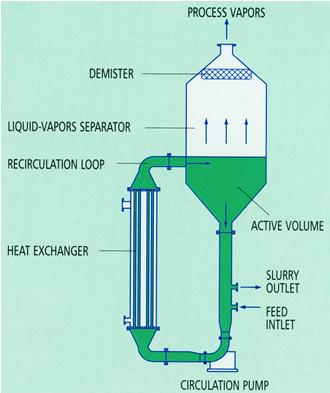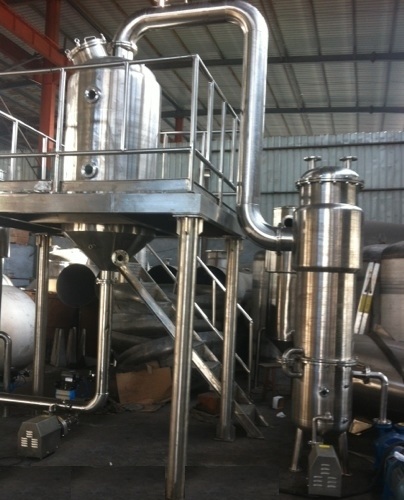Forced Circulation
Continuous forced circulation crystallizer is much like a simple forced circulation evaporator, but it includes specific features to allow correct crystallization, namely:
- an "active volume", designed case by case, to get both required residence time for crystal growth and mother liquor desupersaturation
- a given agitation (recirculation rate) rated to control the extent of supersaturation arising from the evaporation, and to keep the temperature difference in the heat exchanger within reasonable limits
- a special design of the liquid-vapor separation area to minimize the carry over losses and avoid the formation of an excessive amount of fines, which is highly detrimental to crystal growth.

Continuous forced circulation crystallizer
Depending upon specific process requirements, additional devices can be provided. They are:
- internal baffles, used mainly for excess mother liquor overflow and /or withdrawal of fines when crystal growth is slow or disturbed by impurities build-up
- elutriation leg, to improve product purity and to deliver a narrow crystal size distribution
- an internal scrubbing section to reduce to very low value the carry over losses, or even to provide stripping or absorption devices when a volatile compound must be recovered
Forced circulation crystallizers are of the (Mixed Suspension Mixed Product Removal) MSMPR type and operate either on controlled or "natural" slurry density depending upon process requirements and/or unit material balance. These systems can be either single or multiple effects and the vapour recompression concept (either thermal or mechanical) is often applied. Usually, they operate from low vacuum to atmosphere pressure. As a rule, these units are used for high evaporation rates and when crystal size is not of the utmost importance or if crystal grows at a fair rate.


Typical products are:
- NaCl (food or technical grade)
- KNO3
- Na2, SO4
- K2 SO4
- NH4Cl
- Na2CO3H2O
- Citric acid
